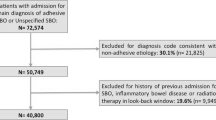Abstract
Introduction
Small Bowel Obstruction (SBO) is a common reason for emergency department (ED) visits in the United States. However, little is known regarding the clinical course of these patients. This study aims to identify all patients presenting to the ED in New York State with SBO and follow their clinical course.
Methods
The New York SPARCS administrative database was used to identify all patients who presented to an ED with the diagnosis of SBO from 2012 to 2014. Patients were followed to identify discharges from the ED, admissions, operations, 30-day readmissions, transfers, and in-hospital death.
Results
Between 2012 and 2014, 43,567 ED visits (events) from 35,646 patients were identified, with 2824 (6.5%) resulting in direct discharge from the ED. A majority (n = 31,193; 71.6%) of ED visits were admitted to the presenting institution without surgery, while 7673 (17.6%) were admitted and underwent surgery. A minority (n = 1947; 4.5%) were transferred to a tertiary center. The overall 30-day readmission rate was 17.9%. Those who underwent surgery were more likely to experience in-hospital death but less likely to have 30-day readmission.
Conclusion
To our knowledge, this is the first study that examines the disposition of all patients presenting to the ED with SBO in a large statewide cohort. The majority of admitted patients underwent non-operative management, with overall low rates of readmission, transfer, and in-hospital death.

Similar content being viewed by others
References
Sikirica V, Bapat B, Candrilli SD et al (2011) The inpatient burden of abdominal and gynecological adhesiolysis in the US. BMC Surg 11:13
Dorsey ST, Harrington ET, Iv WFP et al (2011) Ileus and small bowel obstruction in an emergency department observation unit: are there outcome predictors? Western J Emerg Med 12:404–407
O'Leary EA, Desale SY, Yi WS et al (2014) Letting the sun set on small bowel obstruction: can a simple risk score tell us when nonoperative care is inappropriate? Am Surg 80:572–579
Frasure SE, Hildreth A, Takhar S et al (2016) Emergency department patients with small bowel obstruction: what is the anticipated clinical course? World J Emerg Med 7:35–39
Meier RPH, de Saussure WO, Orci LA et al (2014) Clinical outcome in acute small bowel obstruction after surgical or conservative management. World J Surg 38:3082–3088
Teixeira PG, Karamanos E, Talving P et al (2013) Early operation is associated with a survival benefit for patients with adhesive bowel obstruction. Ann Surg 258:459–465
Wessels LE, Calvo RY, Dunne CE et al (2019) Outcomes in adhesive small bowel obstruction from a large statewide database: What to expect after nonoperative management. J Trauma Acute Care Surg 86:651–657
Malangoni MA, Times ML, Kozik D et al (2001) Admitting service influences the outcomes of patients with small bowel obstruction. Surgery 130:706–713
Aquina CT, Becerra AZ, Probst CP et al (2016) Patients with adhesive small bowel obstruction should be primarily managed by a surgical team. Ann Surg 264:437–447
Behman R, Nathens AB, Byrne JP et al (2017) Laparoscopic surgery for adhesive small bowel obstruction is associated with a higher risk of bowel injury: a population-based analysis of 8584 patients. Ann Surg 266:489–498
Acknowledgements
We acknowledge the biostatistical consultation and support provided by the Biostatistical Consulting Core at School of Medicine, Stony Brook University.
Funding
This research did not receive any specific Grant from funding agencies in the public, commercial, or not-for-profit sectors.
Author information
Authors and Affiliations
Corresponding author
Ethics declarations
Disclosures
Dr. Pryor has received honoraria for speaking from Ethicon, Stryker, Merck and Gore, and consulting honoraria from Medtronic. Dr. Bevilacqua, Altieri, Yang, Zhu, Talamini, and Pryor have no conflicts of interest or financial ties to disclose.
Additional information
Publisher's Note
Springer Nature remains neutral with regard to jurisdictional claims in published maps and institutional affiliations.
Electronic supplementary material
Below is the link to the electronic supplementary material.
Rights and permissions
About this article
Cite this article
Bevilacqua, L.A., Altieri, M.S., Yang, J. et al. Clinical course of patients presenting to the emergency department with small bowel obstruction in New York State. Surg Endosc 35, 3040–3046 (2021). https://doi.org/10.1007/s00464-020-07754-7
Received:
Accepted:
Published:
Issue Date:
DOI: https://doi.org/10.1007/s00464-020-07754-7




